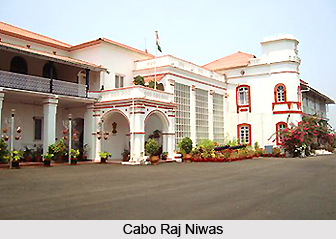 Cabo Raj Niwas was built in 1540 AD opposite the famous Aguada fort on the south headland of the river Mandovi. The Franciscan monastery which was converted into the official residence of the governor of Goa in 1549 AD is located in the premises of the fort. A chapel was built at the end of the mansion dedicated to Nossa Senhora do Cabo, i.e. Our Virgin Lady of The Cape. This chapel served as a landmark for the seafarers.
Cabo Raj Niwas was built in 1540 AD opposite the famous Aguada fort on the south headland of the river Mandovi. The Franciscan monastery which was converted into the official residence of the governor of Goa in 1549 AD is located in the premises of the fort. A chapel was built at the end of the mansion dedicated to Nossa Senhora do Cabo, i.e. Our Virgin Lady of The Cape. This chapel served as a landmark for the seafarers.
The word Cabo was used by the Portuguese which meant `cape.` The fort provides a panoramic view of Goa with the Indian Ocean in the west, the Bay of the river Mandovi, Fort Aguada and busy port of Marmagoa on the North. The fort remained abandoned and isolated for centuries. It is believed that some human habitation must was earlier present here but the enclosure of the fort in a dense wilderness brought about the desertedness of this citadel.
Construction of Cabo Raj Niwas
The accurate date about the construction of the fort is not known until 1540, the eighth Governor, D. Estevao de Gama, proposed the idea of building fortifications at the site of the mansion with the ides of guarding the entrance from Mandovi and Zuari rivers.
A monastery inside the fortress was later built by the Viceroy D. Matias d Albuquerque. He was a protector of the transformed Franciscan friar, which was called "Recollects". The entire construction expenses were met by him and he imposed the instructions that the chapel should be maintained by the believers of the faith and in their absence it should be handed over to the archdiocese for proper maintenance.
The foundation work of the monastery started on 5th February 1594 under the supervision of Bishop de Santa Maria. The work finished within a period of 6 months, i.e. on the date 14th July 1594. The monastery was built of laterite blocks which were abundantly available at the site. The pits formed out of extracting laterite stones were covered to build cisterns. These cisterns used to carry rainwater via the sloping roof of the building.
Raj Niwas
Presently Cabo Palace is known as Raj Bhavan which serves as the official residence of the Governors of the States in India. It is the oldest Raj Bhavan and also the finest one too.
The reception area or the The Darbar Hall consists of a huge hall which is used during reception and other official programs such as the swearing ceremonies. The dining room has a sitting arrangement for thirty people. The living room is also on the same floor where the governor along with his family can live in. The verandah of the building runs along the entire portion that gives a panoramic view of Mandovi ay and Arabian Sea. There are three suites and seven double rooms for guests.
Features on Display in Cabo Raj Niwas
There are several collectibles that are on display inside the mansion such as, Chinese porcelain, Bohemian chandeliers, and silver and wooden furniture. Among the various articles on display the most notable are the pieces of antique Chinese porcelain, presumably manufactured in Canton. A worn-out set of crockery is also showcased having the similar design as that of the Chinese porcelain. All these articles were ordered specially for the use of the Portuguese Governor General. An excellent collection of high quality wooden furniture with exquisite workmanship, a set of intricately carved chairs with figurines of Hindu Gods and Temples indicate the complete harmony between Christians and Hindus that existed in Goa.



















